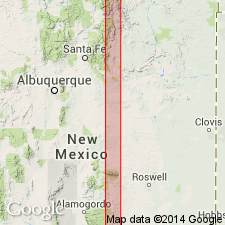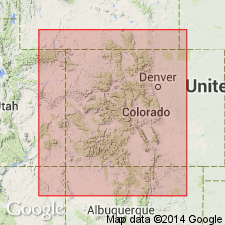
- Usage in publication:
-
- Indian Creek granite
- Modifications:
-
- Named
- Dominant lithology:
-
- Granite
- AAPG geologic province:
-
- Southern Rocky Mountain region
Summary:
Named for Indian Creek Park, Front Range, CO in the Southern Rocky Mountain region. Composed of sixteen plutons which occur in northeast Park Co, southeast Clear Creek Co, and west-central Jefferson Co. Geologic maps. Characteristics of each pluton described on a table and in the text. No specific type locality given for the Indian Creek, but location and area of exposure given for each pluton. The Indian Creek is a granite that is subtrachytoid to porphyritic, of flesh to tan color, and distinguishable by subparallel, similarly oriented lines of tabular idiomorphic feldspar crystals closely crowded and embayed by interstitial quartz, mica, and accessory minerals. Hornblende is absent. Resembles Silver Plume batholith in field relationships, physical appearance, and crystalline character. Plutons occur as four belts of subparallel slightly en echelon granite bodies aligned concentrically along the north and east margins of the Rosalie lobe of the Pikes Peak batholith. Is the youngest pre-Cambrian in the area.
Source: GNU records (USGS DDS-6; Denver GNULEX).

- Usage in publication:
-
- Indian Creek Granite
- Modifications:
-
- Overview
- AAPG geologic province:
-
- Southern Rocky Mountain region
Summary:
Abandoned by Boos (1954) in favor of Silver Plume Granite but some recent use (Puffer, 1972). Occurs in the central Front Range, CO in the Southern Rocky Mountain region. Included with granitic rocks and gabbro of circa 1,400 m.y. (Precambrian Y) age group.
Source: GNU records (USGS DDS-6; Denver GNULEX).
For more information, please contact Nancy Stamm, Geologic Names Committee Secretary.
Asterisk (*) indicates published by U.S. Geological Survey authors.
"No current usage" (†) implies that a name has been abandoned or has fallen into disuse. Former usage and, if known, replacement name given in parentheses ( ).
Slash (/) indicates name conflicts with nomenclatural guidelines (CSN, 1933; ACSN, 1961, 1970; NACSN, 1983, 2005, 2021). May be explained within brackets ([ ]).

